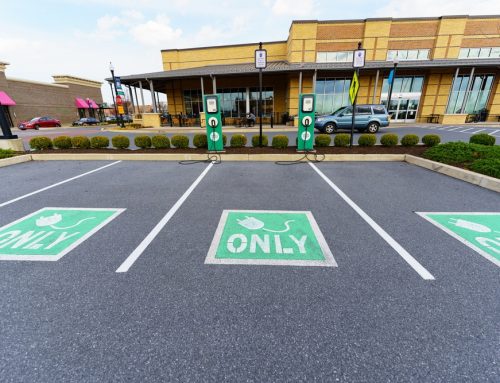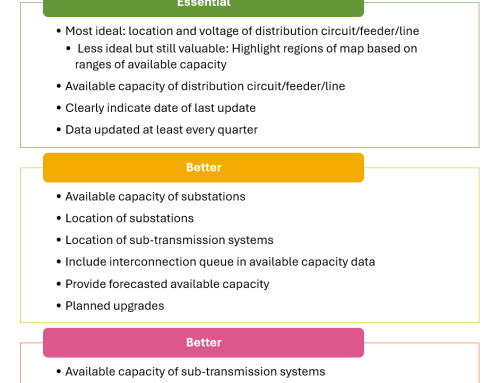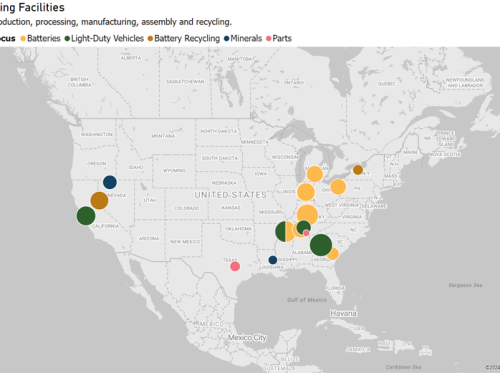
Source: Shutterstock
2023 was a productive year for transportation electrification, and as we bring in the new year, we can only expect that momentum to continue. To reflect on last year and look ahead to 2024, I chatted with some of my colleagues at Atlas who contribute to a spread of meaningful electric vehicle (EV) work at Atlas. In this digest, we hear from Atlas policy associates Jaclyn Lea and Sophie Latham, policy analysts Kelsey Blongewicz and Matthew Vining, and Atlas founder Nick Nigro.
What is an EV development that surprised you in 2023?
Jaclyn: An EV development that surprised me was that we surpassed one million EVs sold in the U.S. in 2023. This was a major milestone for the EV industry and for transportation in general. It is exciting to see that we are moving in the right direction to electrify transportation and reduce greenhouse gas emissions.
Sophie: The amount of investment by private companies in the EV supply chain this year. There has been about $50 billion in 2023 alone. I’m cheating a little bit because this concept isn’t really a huge surprise due to Inflation Reduction Act (IRA) tax credits for EV manufacturing, but it is still an impressive number, and a surprise to me!
Kelsey: I think the trends in EV manufacturing investment and employment have surprised me the most. The new EV Jobs Hub surfaced this data really well and comparing the rate of investment before and after IRA is kind of shocking, as highlighted in this digest. Also noteworthy for me was the geographic distribution of these new investments, especially broken down by political party representation and by disadvantaged communities.
Matthew: As on almost everyone’s mind recently who works in this space, the standardization of the North American Charging Standard (NACS). Earlier this year both General Motors and Ford started the domino effect of original equipment manufacturers (OEMs) joining Tesla, equipping their newer models and EV service equipment with NACS-ready equipment or adapters. It seemed every few weeks there was an announcement of a new OEM joining the trend in the adoption of NACS and now SAE has finally helped solidify it. Developers of EV charging technology can now move forward with more certainty for deployment and commercialization. It is another testament of Tesla’s ability to lead the evolution of this space and hopefully a stronger signal to consumers to lean into the EV market more.
Nick: I was surprised by how quickly GM did a 180 on retiring the Chevy Bolt. Just three months after GM announced its retirement, they gave EV drivers the good news that the Bolt would be back in the near future. It was another example of how fast this market is moving and how autos must be nimble in their response to consumer demand.
What is one piece of work that you worked on that you’re proud of from 2023?
Jaclyn: I work on the Climate Program Portal, and earlier this year, we launched the Outcomes Dashboard which tracks funding awarded from climate programs in the Infrastructure Investment and Jobs Act (IIJA) and the Inflation Reduction Act (IRA). With so many funding opportunities and awards being announced each week, it can be hard to keep track of all of them. So what we’ve done is bring all that information into one place so that people can easily track the implementation of these programs and see where the funding is flowing. This was something that people were really looking forward to, so it has been great to have people use the dashboard to support their work and research.
Sophie: EV Jobs Hub! I’m on an EV manufacturing theme here. Atlas and BlueGreen Alliance Foundation launched the EV Jobs Hub earlier this year, which tracks investments and jobs from both electric vehicle and battery manufacturing. I think it’s an interesting way to see the impact of the IRA tax credits as well as the Justice40 initiative. I’m very proud of the work I did with the team to get it going!
Kelsey: One that stands out is a fact sheet I recently wrote about solutions and strategies for electric trucks and buses to combat cold weather range loss. What excites me about this piece in particular is the relevance for both the EPA’s proposed rule for heavy-duty vehicle emissions standards and the Advanced Clean Trucks rule. Hopefully highlighting success stories of electric trucks and buses deployed in cold climates can help support both of those rules.
Matthew: This year I was on a team between colleagues at Atlas and the BlueGreen Alliance developing an interactive tool tracking investments in the EV manufacturing space, termed the EV Jobs Hub. Since its release earlier this year, the dashboard has proven to be a game changer for those working in EV policy and technical developments. We have already received a wide level of receptiveness to the tool and its usefulness for different lines of work in the EV and climate space. As a new member to Atlas and someone who has been working in the climate and energy policy space, I am proud to have been a part of this piece of work and am looking forward to seeing how the domestic manufacturing sector continues to strengthen.
Nick: Of course, I’m proud of all the work we do at Atlas! Last year, I was glad we got back into one of the thorniest of issues, road funding. Our intern, Nate led the charge and wrote a great paper on the issues surrounding road infrastructure funding and the role of EVs. We dispelled some myths about the contribution to the funding gap from EVs and highlighted equitable policies that are long-term sustainable solutions. The paper accomplished what Atlas does best: we brought together data from a variety of sources, made sense of it, and presented our findings in a way that was accessible to a broad audience. Nate’s paper was the tip of the iceberg on this work and I’m hopeful Atlas will continue to play a constructive role on this important issue.
What are you looking forward to in 2024?
Jaclyn: I’m looking forward to tracking the progress of the National Electric Vehicle Infrastructure (NEVI) Program Program and seeing more NEVI charging stations open in states across the country. As NEVI funding continues to roll out, I’m eager to learn how states will use that funding and how they will tackle NEVI implementation challenges. Atlas has a hand in providing data to help states explore NEVI implementation challenges and bring more attention to the benefits of EVs. Being a part of that effort in making huge strides towards transportation electrification is very rewarding.
Sophie: This is a pretty broad, but I’m generally excited for programs to begin their implementation process and for more funding to roll out during 2024. It has now been a few years since IIJA and IRA were passed, and lots of projects have finally gotten through the application/competition/proposal/construction process. I think it is going to be an interesting year to see a lot more projects get going and start having day-to-day impact beyond the climate space.
Kelsey: Climate Pollution Reduction Grant (CPRG) plans! In early 2024, 45 states (plus DC and Puerto Rico) and numerous metropolitan areas, territories, and tribes will produce economy-wide climate action plans and greenhouse gas inventories, many for the first time. CPRG is exciting to watch because it is designed to empower state and local action on climate and to amplify the impact and uptake of other IRA and IIJA funding programs. So, not only is it notable that so many entities are engaging in climate planning, especially with stakeholder participation and an emphasis on low income and disadvantaged communities, but the potential long-term influence on the clean economy could be huge.
Matthew: I am on a few projects this year that are set to release in Q1 of 2024 that myself and others have been hard at work on. After iteration after iteration of improving the structure and design of these products, it is good to finally start to step back and focus on its use cases for the climate and energy industries. While I can’t reveal more just yet, all I can say now is to keep an eye out!
Nick: I’m looking forward to more fast-charging sites opening up thanks to the NEVI program. Reliable, fast, affordable charging infrastructure is essential for EVs and the NEVI program is helping to lay the groundwork for how to do charging right.
Thanks to Jaclyn, Sophie, Kelsey, Matthew and Nick for sharing thoughts, and we are looking forward to the work ahead this year!


